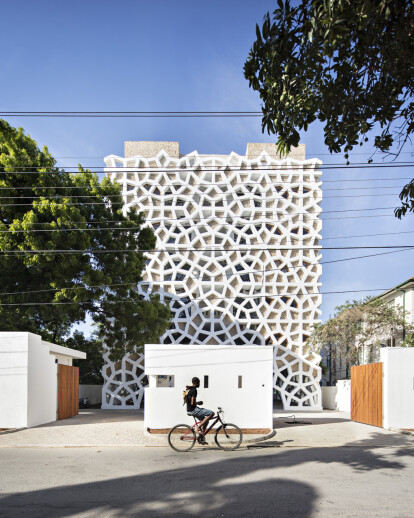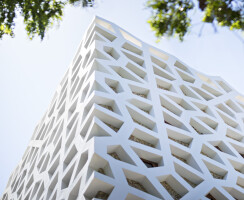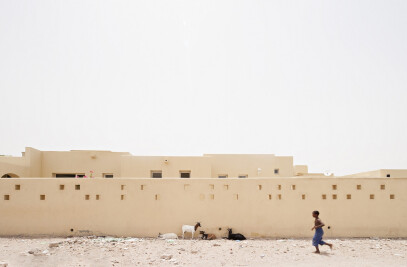Overview The project consists in 14 apartments in Tudor Creek, Mombasa-Kenya. Characterized by a moucharabiah structural shell, it is distinct with its search for privacy and optimized natural ventilation and light. With our vision, the apartments benefit from the experience of outdoor living, contact with nature and the integration of the surroundings into each private home.
Location / context Located on the east coast of Kenya, Mombasa is the second-largest city in the country. A multicultural and strategic centre known for trading and skilled craftsmen, it is characterized by a savanna tropical climate and a land crossed by creeks.
Tudor, our intervention zone, is situated on the creek´s waterfront, which is a privileged location north of Mombasa Island. With lush vegetation all around and a serene neighbourhood, the project naturally fits into this environment.
We worked closely with the client to create a building with minimal environmental impact, by adapting to the land’s natural slope, and by using locally available materials and know-how.
Requirements / Situation Constraints -Maximize the scenery from within and outside the apartments, notably via terraces and balconies
-Environmentally friendly: Naturally aerated spaces: passive cooling. Well-lit spaces, a challenge, as light must come in without the sun heat. Rainwater collection, driven by water scarcity. Solar-heated water for energy saving. Local, long lasting materials
-Ensure privacy regarding theproximity of the road, and that of theneighbours in the adjacent plots: a building of flats on one side, a private house on the other with a risk of major residential development. This was a drive for creating the filtering shell. Proposal
Tudor Apartments is a development that prides itself in its innovative architecture, showing its attachment to Mombasa's history by borrowing inspiration from the rich traditions of Swahili design. This development project is committed to harmonizing Mombasa's past, present and future. The proposal is an intimate development of 14 apartments, all offering breath-taking panoramic views on the creek. We developed aniconic building, with innovation of architectural designs, highest standards of product finishes, luxurious, contemporary lifestyle, and respect for the natural and local heritage.
The plot’s slope and its narrow shape guided our design to minimize the building’s impact. The steep drop towards the creek, on the lower part of the plot, was saved with three distinct and unique patio houses, stepped one into the other. On top of filtering light, the patios allow ventilation via permeable wood lattices facing the water. They are accessible via lateral stairs that descend towards the creek, passing by an integrated gym at the bottom, and arriving to an infinity pool. A measured distance from the neighbours and the road give the building a well-weighted impact, for it to be present but not overwhelming in the scenery. This way, the apartments block, enveloped with its protective skin, rises facing the road, overlooking the creek, and topped with a penthouse.
Environmental features The development was careful to leave the mangroves and other trees intact on site. In addition, natural, passive ventilation was a guiding theme in the project design. In the apartments, cross ventilation is possible from the sea, through the shaded terraces, to the interiors, via the integrated wooden lattices and through the surrounding envelope.
In the distinct bottom houses, the patios allow double ventilation: wood lattices allow air to circulate from the seaside through the interiors and to the patios; two superimposed lattices allow ventilation for both the house and the false ceiling, to avoid it transmitting heat from the sun on the top terraces. Moreover, vegetation is integrated in the patios and on the terraces, offering freshness and greenery.
In the absence of sufficient connection to the sewage system, we integrated a bio-digester for treating used waters before releasing them into nature, that is to say, in the creek water. Furthermore, rainwater collection provides water for care for the garden.
>Structural skin: contemporary muchrabiah We designed the mucharabiah skin following a study of different traditional patterns. It serves for the privacy in relation to the surroundings, and for the filtered, natural light we wanted for the houses.
This skin wraps itself around the apartments block, leaving its Northern façade free, with balconies facing the sea and taking full advantage of the breath-taking scenery.
Moreover, the skin was rendered entirely structuralthanks to the engineering team. A novelty to Kenya, such structural skin was possible thanks to local and international engineers working hand by hand, and to the steel workers on-site who managed, by dedication and care, flawless bar bending work without access to any technology.
Spatially, this skin also redirects people’s local tendency to put bars on their windows, becoming itself the border and the filter. Sometimes the direct limit of the internal house spaces, the shell is at other times a first filter of sunlight and heat, doubled by internal handcrafted wood-lattice shutters. In this way, light is generous and heat is broken down.
>Crafts, techniques, team work In addition to white, plaster finishing, the project uses mtomo finish, a coral stone cladding technique original to Lamu that helps keep thermal capacity thanks to the porosity of the coral stone. Wood work was realised entirely thanks to outstanding hand carving by local artisans from Mombasa and Lamu. Furthermore, artisans produced in situ terrazzo for the flooring of the patio houses

































